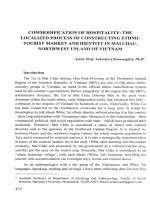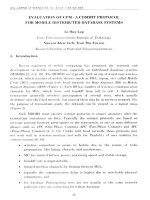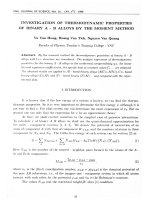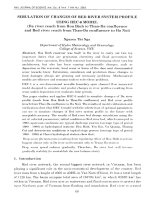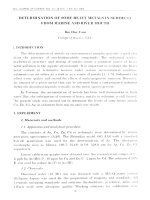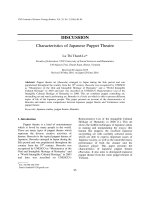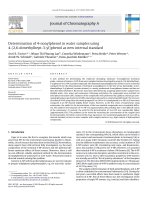DSpace at VNU: Construction of fuzzy if-then rules by clustering and fuzzy decision tree learning.
Bạn đang xem bản rút gọn của tài liệu. Xem và tải ngay bản đầy đủ của tài liệu tại đây (2.41 MB, 6 trang )
VNU. JOURNAL OF SCIENCE. Nat., Sci.. & Tech., T .x x , N02, 2004
C O N S T R U C T IO N O F F U Z Z Y IF -T H E N R U LE S BY C L U S T E R IN G
A N D F U Z Z Y D E C IS IO N T R E E L E A R N IN G
D inh M anh T u ong
Faculty o f Technology, VN U
Abstract. In this paper we propose the method of constructing fuzzy if-then'rules f r o m a
set of input-output data. This method consists of two steps. We first construct fuzzy sets
covering input and output spaces by clustering. Then applying decision tree learning algor ithm
with some suitable changes we construct the fuzzy decision tree. Prom this tree we can generate
fuzzy if-then rules.
1. INTRODUCTION
A fuzzy system consists of two basic components: the fuzzy rule base and the
fuzzy inference engine. Fuzzy systems have been applied in many fields such as
control, signal processing, communications, integrated circuit m anufacturing, and
expert systems to business, medicine, etc. The fuzzy rule base comprises th e following
fuzzy if-then rules:
If
Xj
is Aj and ... and
x„
is A n th e n
y
is B ,
where A| are fuzzy sets in input spaces X; c R (i = 1,
n), and B IS a fuzzy set in
output space Y c R. In many application domains, when developing the fuzzy system,
by observing we obtain a set of input-output data. There are many methods of
designing fuzzy systems from the set of input-output data (see [3, 5, 6]). The design of
fuzzy systems from input-output data may be classified in two types of approaches. In
the first approach, fuzzy if-then rules are first generated from input-output data, then
other components of the fuzzy system are constructed from these rules according to
certain choice of fuzzy inference engine, fuzzifier, defuzzifier. In th e second approach,
the structure of th e fuzzy system is specified first with some p aram eters in the
structure, and then these parameters are determined according to the input-output data.
In this paper we propose th e method of constructing fuzzy if-then rules from a set
of input-output data by clustering and fuzzy decision tree learning. In th e section 2 we
construct the fuzzy set systems th a t cover the input and output spaces. In th e section 3
the fuzzy decision tree will be constructed.
2. CONSTRUCTION OF COMPLETE AND CONSISTENT SYSTEMS OF FUZZY SETS
FOR THE INPUT AND OUTPUT SPACES
Suppose th a t we need to design a system with n inputs X|,
x n and a output y.
Each variable X, (i = 1,
n ) obtains values in the space X, = [a;, b,] c R, and y
obtains values in the space Y = [c, d] c R.
72
Construction o f fuzzy if - then rules by clustering and
73
Suppose th a t we are given the set D of input-output data pairs (x, y), where X =
(xl5
Xj,
xn) is the vector of inputs, y is the output according to X . Our objective is to
construct fuzzy if-then rules from th e set D of input-output data.
We denote:
Dj =
{X j
I
Xj
is th e ith component of X , (x, y) e D}
D’ = {y I (x, y) 6 D}
Therefore D, is the set of points in the space X, = [an bj] (i = 1,
n), and D’ is the
set of points in th e space Y = [c, d]. We want to construct fuzzy sets A'j,
A'mi th at
cover the space X, from the data set Dị (i = 1,
n), and construct fuzzy sets Bj,
Brn
th a t cover th e space Y from the data set D\
D e fin itio n :
1. The system of fuzzy sets A],
Amin the space X is called a complete system if
for any X € X th e re exists a fuzzy set Ak (1 < k < m) such th a t the membership degree of
X in the fuzzy set Ak is g reater th a n zero, th a t is p.Ak(x) >02. The system of fuzzy sets Aj,
Am is called a consistent system if at arbitrary X
G X th a t nAk(x) = 1 th en |aAj(x) = 0 for all j * k, 1
space X.
Suppose th a t D is a set of points in X = [a, b]. From the data set D we construct
fuzzy sets Ai,
Ani th a t cover X as follows. We first divide the data set D into m
clusters Cj,
Cm using clustering algorithms. For doing th a t we can apply one of
following well-known clustering algorithms: k-Means, k-Medoids, or DBSCAN (see [1, 2]).
Suppose th a t x0 is the center of cluster c, then the radius r of cluster c is defined as
From th e centers and radii of clusters Cb
Crn we have alternatives to construct
the fuzzy sets A|,
Am covering the space X = [a, b]. For example, if the data set D is
grouped into th re e clusters with centers Xj (i = 1, 2, 3) and radii r, (i = 1, 2, 3)
corresponding, th e n we can construct trapeziform fuzzy sets A], A2, A;- as specified in
the figure 1.
a x
,
x2
x3
Figure I . Trapeziform fuzzy sets covering x= la. bI
VNU. Journal o f Science, Nat., Sci.. it Tech.. T.xx. N02 , 2004
\
h
74
Diiih Manh Tuong
Using the above represented method, by clustering th e da ta set Dị into the
cluster C'u
C'mi, we construct th e fuzzy sets A*!, A'mi covering th e in p u t space Xị =
[aj, b|] (i = 1,
n). Analogically, from the data set D’we construct th e fuzzy sets
Bj,
Bmcovering the output space Y = [c, d].
For Xj e Xj, we say th a t “Xj is A'j” if j is defined as:
J = arg max ụ , ( * , )
1<,k
t = arg max ụ B ( y )
Is j
T hat is,B, is a fuzzy set such t h a t /UB ( ^ ) = max \jlib ( > 0 v , Mb. ừ ) Ị
By the above represented technique, we have discretizated th e continuous space
Xi = [a|, b j by finite num ber of values A*!,
A‘mi. Each ith input Xj will obtain one of the
fuzzy sets A1!,
A‘mi as his value. Analogically, th e output y can obtain one of fuzzy
sets Bj,
Bm as his value.
3. CONSTRUCTION OF THE FUZZY DECISION TREE
111 this section we present the method of constructing the fuzzy decision tree from the set
D of input-output data. The fuzzy decision tree will be constructed by applying the decision tree
learning algorithm (see [2, 4]) with some suitable changes.
In the fuzzy decision tree when the input X, is the label of a node, below this node there
are nij branches with labels being fuzzy sets A ' l , A ‘mi as in the figure 2.
Figure 2. A node o f the fuzzy decision tree with label Xj
The fuzzy decision tree will be constructed by developing th e tree starting from
the single-node tree. In each step, an unlabeled leaf node will be selected to develop ( to
develop a node means to assign a label to this node and to define branches (if any)
going down from this node). In th e process of developing the tree, when a node is
selected to develop (a node th a t is selected to develop is called c u r r e n t node), we
should choose an in p u t variable to be the label of this node. If th e variable X; is selected
VNỤ. Journal o f Science, Nat.. Sci., & Tech., T.xx. N02 , 2004
Construction o f fuzzy if — then rules by clustering and .
75
to be the label of c u rre n t node, there will be nij branches with labels A'1?
A'mi going
down from th is node as in the figure 2. The c u rre n t node can be not developed and will
become a leaf of resu ltin g decision tree. This leaf will be labeled by one of the fuzzy sets
Bj, ... Bm. The choice of label of the cu rrent node is performed by using the entropy
measure. The entropy is employed as a measure of the impurity in a collection of data.
Given a subset s of the set D of input-output data
s = |(*,>') I (•x , y ) e ũ }
Because the ou tp ut can take on m different values as fuzzy sets B ị ,
entropy of s is defined as follows
« r
£
Mb , ( y )
Bm, the
(1)
( V,» )e5
m
a
=
Ỷ
a J
7= 1
a
pj = —
a
u = l r , ni)
Ent ropy ( S ) = Ỳ - P j log 2 p j
(2)
7=1
Suppose t h a t s is the data set going into the node with label
X,
(see the figure 2),
we denote Sj as the subset of s , Sj consists of all data going into the branch with label
A’j. The expected entropy of s after using the variable X, to partition s , denoted by
ExpEntropy(S,Xj), is defined as follows
ExpEntropy ( s , Xị )
= yT —
J c
7=1
Entropy ( s
)
(3)
ỏ
where Sj is the number of elements of Sj, Sj = I Sj I, and s = Is I. Therefore, the expected
entropy is simply the sum of the entropies of each subset Sj, weighted by the fraction of
d ata th a t belong to Sj.
We now assum e that a node is selected to develop and s is the set of data going
into th is node. T he in p u t variable Xj will be assigned to be th e label of c u rre n t node if
ExpEntropy (S, Xj) is the sm allest in all ExpEntropy(S, Xj), where Xj is not on the road
from the tree root to the current node. That is, if we denote IND as the set of indices j
such that Xj are not label of nodes on the road from the tree root to the current node,
then Xj will be the label of the node, where i is defined by
V N U . Jou rna l o f Science, N ut., S c L & Tech.,
T.xx. N J ,
2004
Dinh M a n h T u o n g
76
/ = arg min ExpEntropy {S, x ị)
(4)
je lN D
If the set of d ata s goes into a branch and Entropy(S) is small enough, th a t is
Entropy(S)< 8, where £ is a given positive constant, then this branch will go into a leaf
of resulting decision tree, this leaf is labeled by Bk, where k is defined as
k = arg max a
\<>j
(5)
J
The following is algorithm of constructing the fuzzy decision tree.
A lgorithm :
- Create a root node of the tree with the data set D going into this mode
- Repeat
1. Select a node (an unlabeled leaf of the current tree) to develop. Suppose th a t s
is the data set going into the current node.
2. If s is empty then the current node is a leaf of the resulting tree, this leaf is
labeled by Bk, where k is defined by (5) with
aj=
z VB, (y)
ị x ty ) e S '
where S’ is the data set going into the parent node of the cu rren t node
3. Else Begin
3.1. If Entropy(S) < 8 or IND is empty then the cu rren t
resulting tree with label Bk, where .k is defined by (1) and (5).
node is a leaf of the
3.2. Else Begin
3.2.1. The c u rre n t node is labeled by Xj where i is defined by (4).
3.2.2. Below this node there are m, branches with labels A'j,
A'm„these
branches lead to new nodes. The data set going into the branch A'j is Sj (j = 1,
m,),
where Sj is defined as
End
End
Until all leaves of the tree are labeled.
From the constructed fuzzy decision tree, we can construct fuzzy if-then rules.
Each road from the tree root leading to a leaf generates a fuzzy if-then rule.
VNU. Journal o f Science, Nat.. Sci., & Tech., I'.XX. Nit2. 2004
C on stru c tio n o f fuzzy if - t h e n ru les by clustering and
77
CONCLUSION
Above we proposed th e method of constructing fuzzy if-then rules from a set of
inp ut-output data. This method consists of two steps. We first construct the systems of
fuzzy sets covering the input and output spaces by using well-known clustering
techniques. Then applying decision tree learning algorithm with some suitable changes
we construct th e fuzzy decision tree. From this tree we generate fuzzy if-then rules,
each ru le is corresponding to a road from th e tree root leading to a leaf.
REFERENCES
1.
M. Ester, H. p. Kriegel, J. Sander, and X. Xu. A density-based algorithm for
discovering clusters in large spatial databases, Proceedings o f 2nd Int. Conf. on
Knowledge Discovery and Data M ining, Portland, OR, Aug., 1996, pp.226-231.
2.
J. Han and M. Kamber. Data Mining: Concepts and Techniques, Morgan Kaufmann,
Publishers, San Francisco, 2001, 550p.
c. T. Lin. Neural fuzzy control systems with structure and Parameter Learning, World
Scientific, Singapore, 1994, 318p.
3.
4.
T, M. Mitchell. Machine Learning, McGraw-Hill, Inc., 1997, 414p.
5.
L. X. Wang and J. M. Mendel. Generating fuzzy rules by learning from examples, IEEE
Trans. On Systems, Man, and Cybern., 22(6), 1992, pp. 161-170.
(>. L. X. Wang. A course in Fuzzy Systems and Control, Prentice-Hall Int., Inc., 1997,
424p.
TAP CHỈ KHOA HỌC ĐHQGHN, KHTN & CN, T .x x , So 2. 2004
XÂY D ự N G CÁC LUẬT IF - THEN MỜ BANG PHƯƠNG PHÁP
PHÂN CỤM VÀ HỌC CÂY QUYẾT đ ị n h m ờ
Đ in h M ạ n h T ường
Khoa Công nghệ, ĐHQG H à Nội
Trong bài này chúng tôi đề xuất một phương pháp xây dựng các lu ật if-then mờ
từ một tập các cặp dữ liệu vào-ra. Phương pháp này gồm hai giai đoạn. Đầu tiên áp
dụng kỹ th u ậ t p hân cụm, chúng ta xây dựng các hệ tập mờ phủ các không gian dữ liệu
vào-ra. Sau đó bằng cách áp dụng th u ậ t toán học cây quyết định vối một sô thay đôi
thích hợp, chúng ta xây dựng cây quyêt định mờ. Các luật if-then mờ sẽ được hình
th à n h từ cây quyết định này.
V N U . Journal o f Science, Nat., Sci., & Tech., T.xx, N02. 2004

